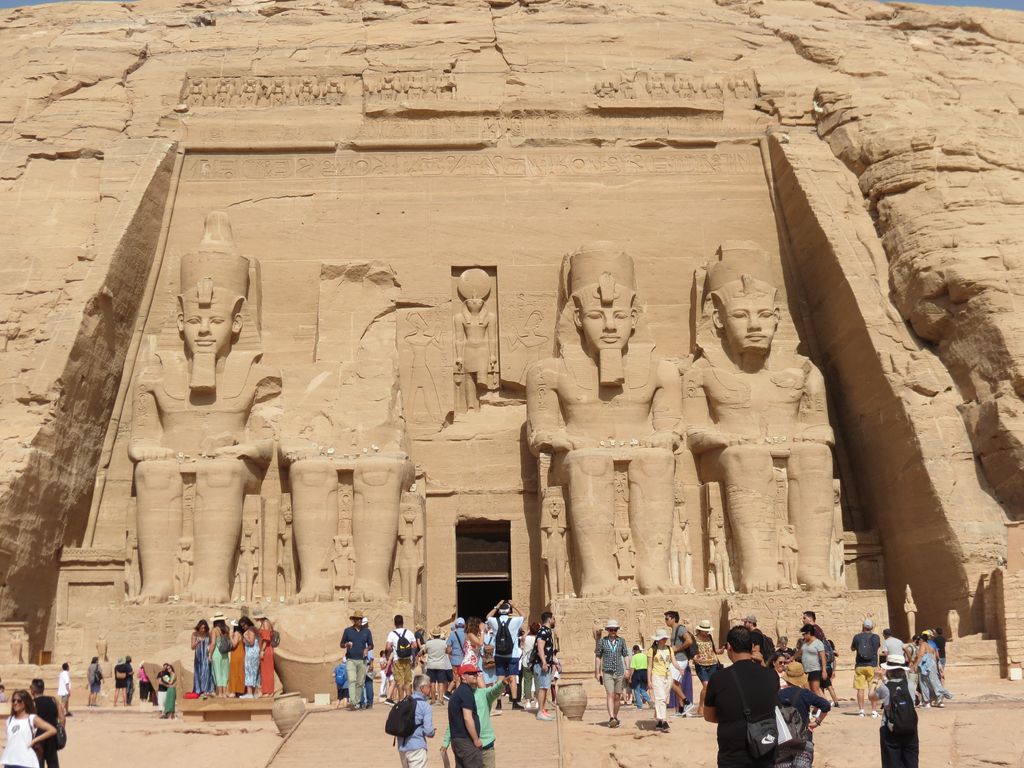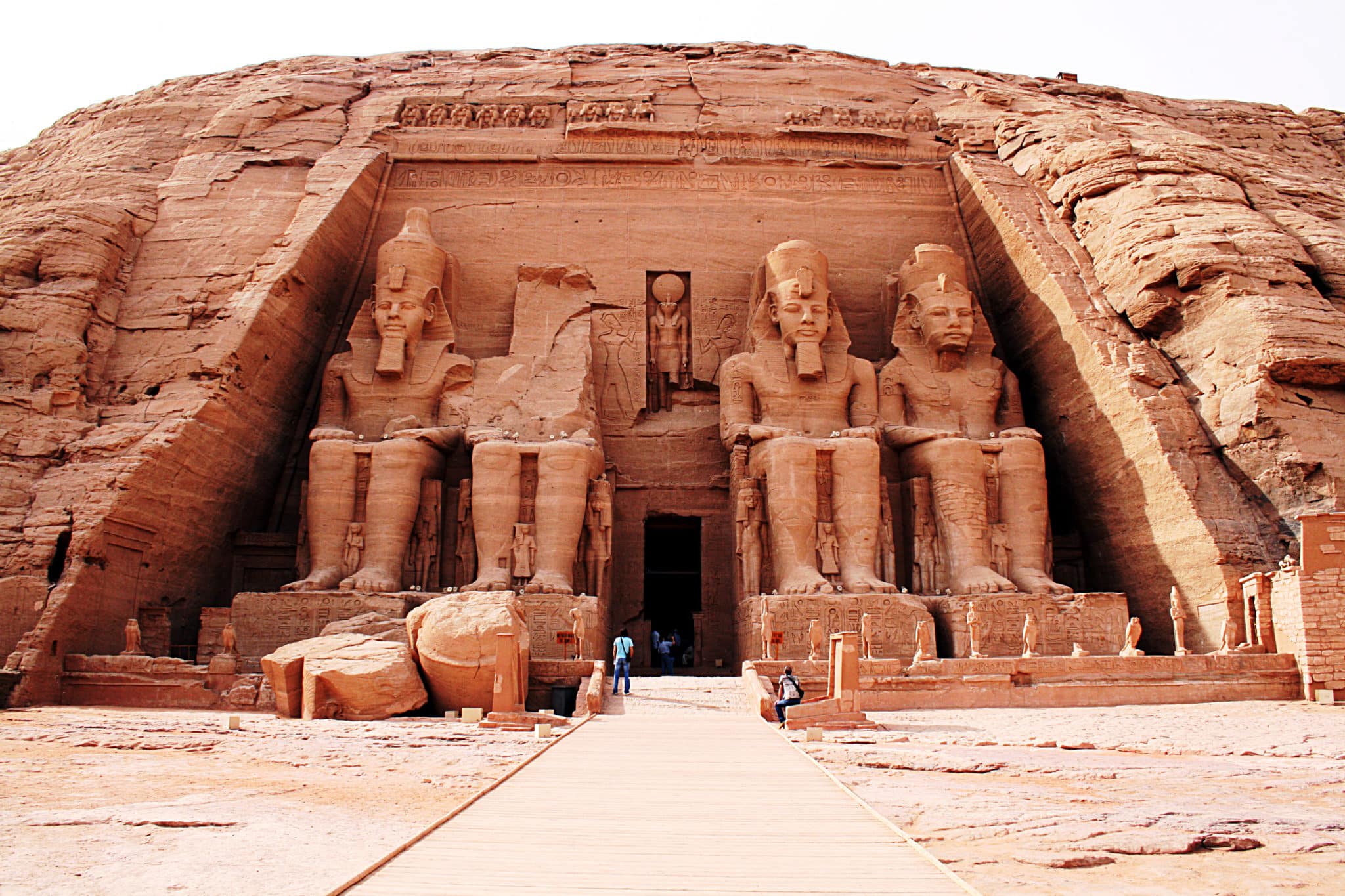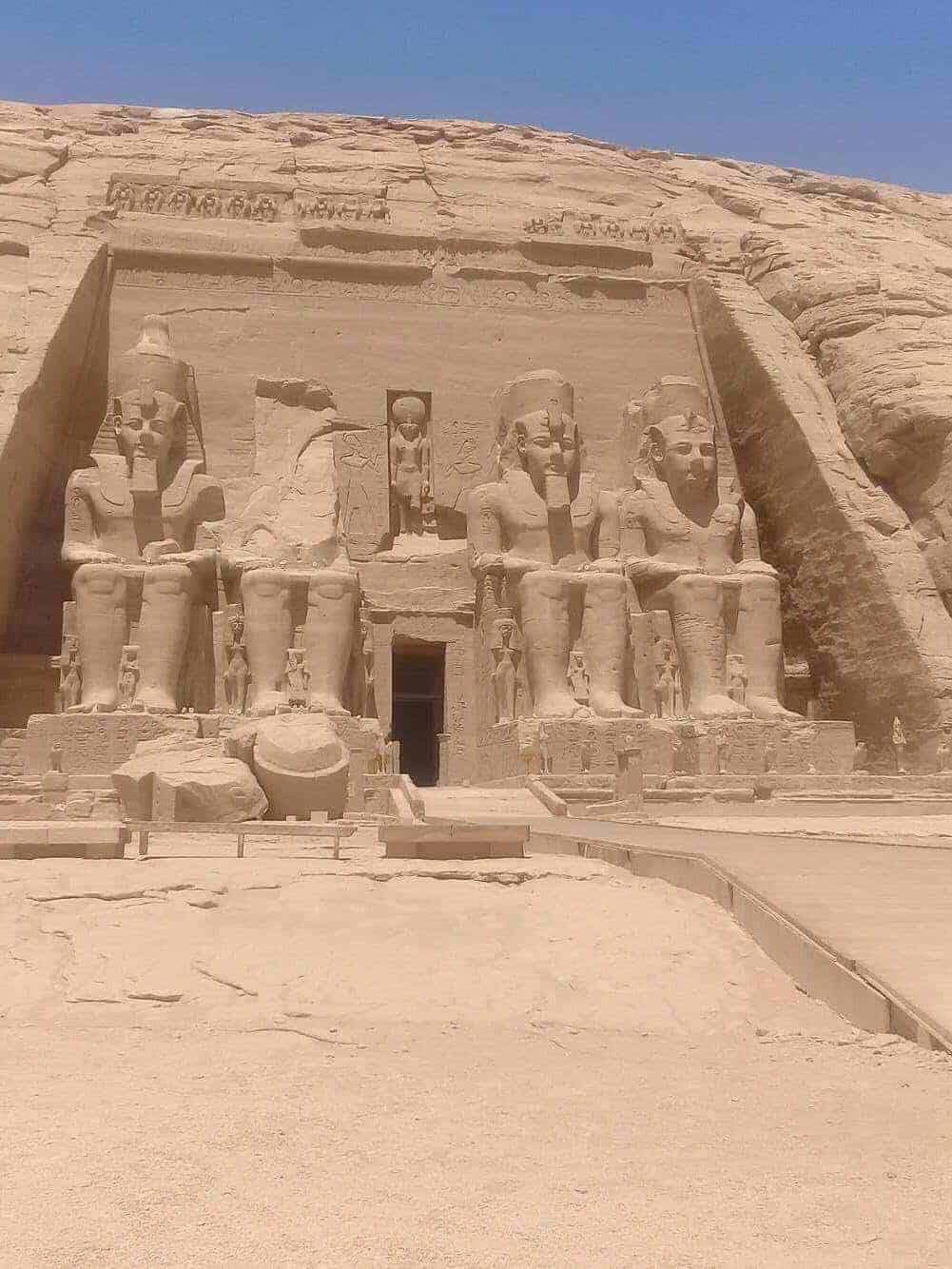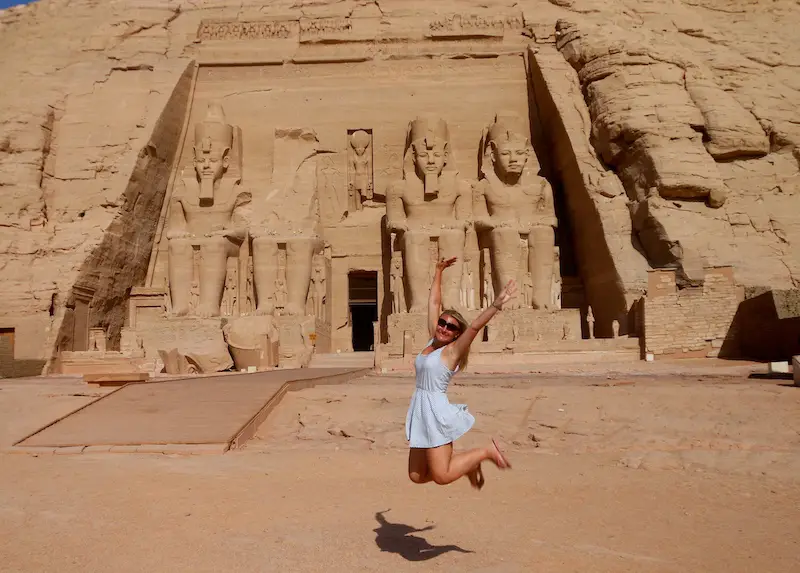Discover the Incredible Abu Simbel Temples in Egypt

Abu Simbel is a mesmerizing archaeological site in Egypt home to two magnificent temples. These impressive structures have a rich history and showcase the grandeur of ancient Egyptian architecture. Exploring the Abu Simbel Temples is like stepping back in time and witnessing the remarkable achievements of the Pharaohs. This blog section will overview the Abu Simbel Temples and discuss their historical significance.
Overview of Abu Simbel Temples
The Abu Simbel Temples are located in the southern part of Egypt, near the border with Sudan. They were constructed during the reign of Pharaoh Ramesses II in the 13th century BC. The main temple, the Great Temple of Abu Simbel, is dedicated to the gods Ra-Horakhty, Ptah, and Amun-Ra. The smaller temple is dedicated to Ramesses II's wife, Queen Nefertari.
Both temples are carved into the mountainside, creating a stunning façade that captivates visitors. The exteriors are adorned with colossal statues of the pharaoh, standing at around 65 feet tall. These statues, with their intricately carved details, are an impressive testament to the skill and craftsmanship of ancient Egyptian artisans.
Inside the temples, visitors can marvel at the elaborate wall reliefs and hieroglyphics, which depict scenes from the lives of the pharaohs and various mythological tales. The ceilings of the main temple are adorned with astronomical depictions, including a remarkable solar alignment that occurs twice a year. During the alignment, the sunlight penetrates the temple's innermost sanctuary and illuminates the statue of the sun god Ra.
Historical Significance of Abu Simbel
The Abu Simbel Temples hold immense historical significance. They were originally built to commemorate Pharaoh Ramesses II's victory at the Battle of Kadesh and assert his authority over Nubia (present-day Sudan). The temples also served a religious function, with their grandeur designed to demonstrate the pharaoh's devotion to the gods.
The Abu Simbel Temples went through several changes throughout history. They were rediscovered in 1813 by Swiss explorer Johann Ludwig Burckhardt and later relocated in the 1960s due to the construction of the Aswan High Dam. This monumental relocation effort, supported by UNESCO, saved the temples from being submerged under the waters of Lake Nasser.
Today, the Abu Simbel Temples continue to awe and inspire visitors worldwide. They are recognized as a UNESCO World Heritage Site and provide valuable insights into the ancient Egyptian civilization. Exploring these temples is an unforgettable experience, offering a glimpse into the extraordinary achievements of one of history's greatest civilizations.
The Abu Simbel Temples in Egypt are a testament to ancient Egypt's grandeur and architectural brilliance. Their intricate designs, colossal statues, and historical significance make them an absolute must-visit for anyone interested in ancient civilizations and world heritage.

The Temple of Nefertari
Have you ever dreamed of exploring ancient Egyptian temples and immersing yourself in their rich history? The Abu Simbel Temples in Egypt are an incredible archaeological site that should be on every traveller's bucket list. Among these magnificent structures is the Temple of Nefertari, dedicated to the great queen. Let's dive into this remarkable temple's features, layout, and historical significance.
Features and Layout of Nefertari Temple
The Temple of Nefertari: is a small but stunning temple located in the southern part of Egypt, near the border with Sudan. It was constructed during the reign of Pharaoh Ramses II, in the 13th century BCE, as a tribute to his beloved wife, Nefertari. The temple is beautifully carved into the rock face and adorned with intricate hieroglyphics and stunning artwork.
The temple entrance greets visitors with four colossal statues of Pharaoh Ramses II himself, standing at an impressive 65 feet tall. As you enter, you'll find a central hall with pillared corridors featuring elaborate carvings depicting important events from the pharaoh's reign.
One of the highlights of the Temple of Nefertari is the sanctuary dedicated to the goddess Hathor. The sanctuary's walls are decorated with reliefs of Nefertari and Hathor, emphasizing the queen's divine role and close connection to the goddess. The temple also houses smaller chambers dedicated to other deities, further showcasing the religious significance of this sacred site.
Importance of Nefertari in Egyptian History
Nefertari, the Great Royal Wife of Pharaoh Ramses II, held a special place in Egyptian history. She was not only admired for her beauty but was also known for her intelligence, charm, and strong influence on her husband. Nefertari played a crucial role in diplomatic relations with neighbouring kingdoms and even negotiated with the powerful Hittite Empire.
The construction of the Temple of Nefertari was a testament to Ramses II's love and respect for his queen. It symbolized their eternal bond and ensured that Nefertari would be venerated for future generations. The temple also served as a place of worship and pilgrimage, where devotees sought the goddess Hathor's blessings and honoured the queen's memory.
Exploring the Temple of Nefertari is like stepping back in time and witnessing ancient Egypt's devotion and artistic mastery. Its intricate carvings, grand statues, and sacred atmosphere offer a glimpse into this magnificent civilisation's rich cultural heritage.
So, whether you're a history enthusiast or fascinated by the wonders of the world, a visit to the Abu Simbel Temples, especially the Temple of Nefertari, is an experience that will leave you in awe of Egypt's glorious past.

Relocation of the Temples
The Abu Simbel Temples are an awe-inspiring architectural marvel located in Egypt. Dating back to the 13th century BC, these ancient temples were dedicated to the Pharaoh Ramesses II and his wife, Nefertari. The temples were originally carved out of a mountainside, but due to the construction of the Aswan High Dam and the threat of flooding, they had to be relocated to higher ground.
Reasons Behind the Relocation Process
The main reason behind the relocation of the Abu Simbel Temples was the construction of the Aswan High Dam. The dam, built across the Nile River, created the reservoir known as Lake Nasser. As the lake began filling up, it threatened the temples as they could be submerged underwater and lost forever.
The Egyptian government decided to embark on an ambitious relocation project to preserve these historical treasures. The temples were cut into enormous blocks weighing up to 30 tons each and then meticulously reassembled 65 meters higher and 200 meters away from their original location.
Challenges Faced during the Relocation
The relocation of the Abu Simbel Temples was a challenging engineering feat. The sheer size and weight of the structures made it difficult to move them without causing any damage. The relocation process had to be carefully planned and executed to ensure the temples remained intact.
Another challenge faced during the relocation was preserving the artwork and hieroglyphs inside the temples. The intricate carvings and paintings had to be protected from potential damage during dismantling and reassembly.
Despite these challenges, the relocation project was a success. The Abu Simbel Temples now stand in their new location, open for visitors to marvel at their grandeur and historical significance.
Here's a table summarizing the relocation of the temples:
| Abu Simbel Temples | |
|---|---|
| Original Location | Mountainside |
| New Location | Higher ground 65 meters above |
| Reason for Relocation | Threat of flooding due to Aswan High Dam |
| Challenges | Moving massive structures without damage |
| Preserving intricate artwork and hieroglyphs |
Visiting the Abu Simbel Temples is a truly breathtaking experience. The intricate carvings, colossal statues, and rich history make these temples a must-see destination for history enthusiasts and travellers alike. Whether you are fascinated by ancient Egyptian civilization or appreciate architectural wonders, the Abu Simbel Temples will leave a lasting impression.

Abu Simbel Light and Sound Show
The Abu Simbel Temples are undoubtedly one of Egypt's most remarkable archaeological sites. They are located near the southern border with Sudan and are dedicated to the pharaoh Ramesses II. While the temples are awe-inspiring during the day, they become even more magical at night during the Abu Simbel Light and Sound Show.
Details of the Light and Sound Show
The Abu Simbel Light and Sound Show is a captivating audio-visual experience that brings the history of these ancient temples to life. The show takes place in the evening, allowing visitors to witness the temples illuminated against the night sky. Spectators are seated in front of the temples' façades, where the show is projected onto the massive stone structures.
During the 45-minute show, a combination of lights, music, and narrations in different languages provide a mesmerizing journey through time. Visitors are transported back to ancient Egypt as the stories of pharaoh Ramesses II, his queen Nefertari, and their legendary reign unfold. The narration skillfully weaves historical facts, mythology, and legends, making the experience educational and entertaining.
Experience and Highlights of the Show
Attending the Abu Simbel Light and Sound Show is an unforgettable experience for anyone visiting Egypt. Here are some of the highlights:
-
Impressive Visuals: The illumination of the temples creates a stunning backdrop against the night sky. The intricate carvings, colossal statues, and detailed hieroglyphics are brought to life through the fascinating play of lights.
-
Engaging Narration: The narration during the show provides in-depth insights into the history and significance of the Abu Simbel Temples. Visitors learn about the construction of the temples, their purpose, and the religious beliefs of the ancient Egyptians.
-
Emotional Impact: The combination of music, lights, and storytelling invokes a sense of awe and reverence. Watching the temples glow and hearing the stories of the pharaohs in such a dramatic setting can evoke powerful emotions.
-
Cultural Connection: The Abu Simbel Light and Sound Show allows visitors to connect with the ancient Egyptian civilization on a deeper level. It provides a unique opportunity to immerse oneself in the history and traditions of this remarkable culture.
Watching the Abu Simbel Light and Sound Show is like stepping back in time to witness the grandeur of the ancient world. The show adds a whole new dimension to the experience of visiting the Abu Simbel Temples, making it an absolute must-see for tourists in Egypt.
So, if you're planning a trip to Egypt, include the Abu Simbel Light and Sound Show in your itinerary. It's an extraordinary way to appreciate the splendour and significance of these magnificent temples.

How to Visit Abu Simbel
Abu Simbel: is an awe-inspiring ancient temple complex located in southern Egypt, near the border with Sudan. Built during the reign of Pharaoh Ramesses II in the 13th century BC, these temples are a UNESCO World Heritage Site and attract tourists worldwide. If you're planning a trip to Egypt, visiting Abu Simbel should be on your itinerary. Here's how you can make the most of your visit.
Travel Information and Accessibility
Getting to Abu Simbel: The temples are situated about 280 kilometres (175 miles) south of Aswan, and the easiest way to reach them is by flying. Aswan has its own airport and daily flights to Abu Simbel. The flight lasts approximately one hour, and once you arrive, a shuttle bus will take you to the temple complex.
Visiting during the Winter Solstice: One of the fascinating aspects of Abu Simbel is its alignment with the sun. On February 22 and October 22 of each year, the rising sun illuminates the temple's inner sanctuary, illuminating the statues of the gods inside. It is a breathtaking sight and a must-see for visitors. If you're interested in witnessing this phenomenon, plan your visit during these days.
Ticketing and Tour Options
Entrance fees: To enter the Abu Simbel temples, you must purchase a ticket. The cost for foreigners is generally higher than for Egyptian nationals. Prices may differ depending on whether you include a guided tour or an audio guide.
Guided tours: Hiring a professional guide is highly recommended as they can provide valuable insights into the history and significance of the temples. Guides are available at the entrance, or you can arrange a private guide in advance.
Audio guide: Audio guides are available in multiple languages if you prefer to explore at your own pace. These guides provide detailed information about each section of the temple complex, allowing you to learn as you wander.
Here's a table to summarize the information:
| Aspect | Abu Simbel |
|---|---|
| Location | Southern Egypt, near the Sudanese border |
| Travel Method | Flight from Aswan to Abu Simbel |
| Duration of Flight | Approximately one hour |
| Temple Illumination | February 22 and October 22 during the Winter Solstice |
| Entrance Fees | Varies for foreigners and Egyptian nationals |
| Guided Tours | Available at the entrance or can be arranged in advance |
| Audio Guides | Available in multiple languages |
Visiting Abu Simbel is a mesmerizing experience that will transport you back to the golden age of ancient Egypt. The grandeur and intricate details of the temples will leave you in awe. Don't miss the opportunity to explore this remarkable UNESCO World Heritage Site during your visit to Egypt.
